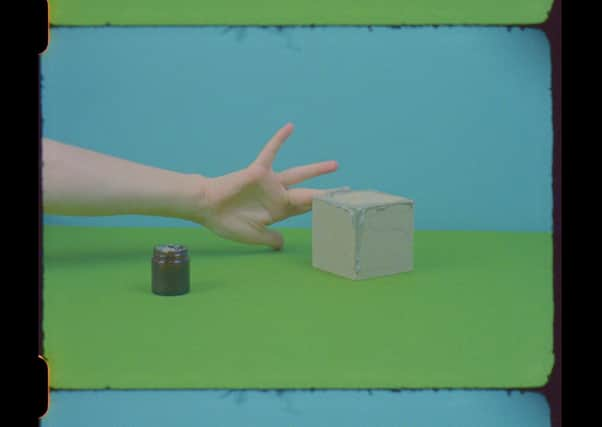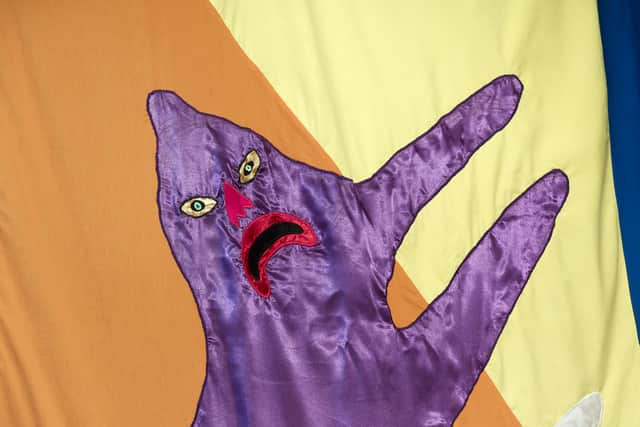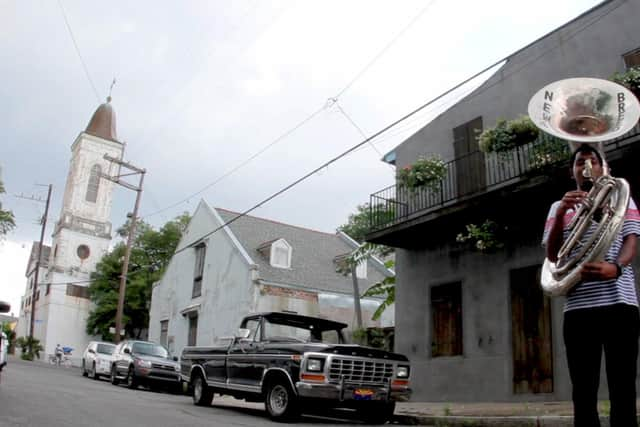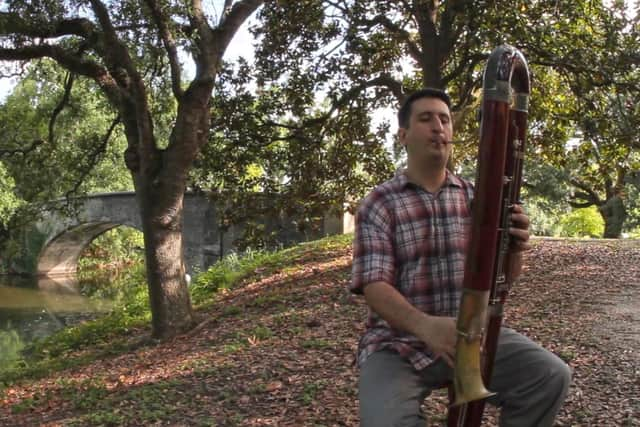Art reviews: Meet Me at the Threshold | Cauleen Smith: H-E-L-L-O


Meet Me at the Threshold, Talbot Rice Gallery, Edinburgh ***
Cauleen Smith: H-E-L-L-O, Collective, Edinburgh ***
Opportunities for emerging artists are always thin on the ground, so one must applaud the fact that Edinburgh’s Talbot Rice Gallery offers a two-year package of support for five “residents” each year in a programme funded by the Freelands Foundation. The group exhibition Meet Me at the Threshold showcases the first ten artists who took part between 2018-20 and 2019-2021.


Advertisement
Hide AdThe work ranges widely in themes and approach, and also in scale: some of the artists are showing major pieces, others fragments from what one guesses is a much larger practice. Some, like Rae-Yen Song and Tako Taal, who made impressive work at Dundee Contemporary Arts earlier this year, have already had bigger shows elsewhere.
The White Gallery houses work by five artists with a slightly disjointed, degree-show feel. Song’s work, while it doesn’t have the scale of the DCA installation, still stands out: three banners, a sculpture and a selection of drawings in the artist’s signature style, part kitsch, part personal mythology. Song’s work is a private exploration of issues around family and identity which doesn’t give up easy meanings, but still makes an impact through its strong use of colour and imagery and the quality of its execution.
Sarah Rose is a sculptor who is also capable of spectacle – witness her flying dragon in Talbot Rice’s 2021 show The Normal – but here she presents a group of smaller interlinked works. Her concerns and research meander through them: the shed “skin” of a snake, which also references the casings made for the first underwater telecommunications cables, the musical instrument known as the “serpent”. But their modest scale means they are a little lost here, and we need the background text to understand their significance.
The same is true of Stephanie Mann’s work, which draws on scientific research and processes. Having obtained four discarded objects from Edinburgh University’s collection, she has cut a core through each object and ground the pieces into dust which she massages into sandstone and turns into dye. However, one is left with the sense that the processes are more interesting than the visual works are able to convey.


Mona Yoo explores the experience of living between two cultures with a sound work in which her tired voice chants Morse code, first in English then Korean, to an unheeding audience. A pulsing light, barely visible in day time, continues after the gallery closes but, in practice, both the light and the voice are easy to miss. A handful of photograms in a corner by Rosie O’Grady isn’t really enough to convey what the wider scope of her work is about.
However, the show gathers strength in the inner spaces of the gallery. Jenny Hogarth’s powerful film installation, Flow Co Motion, is a portrait of her relationship with her son, Bo, who has autism. Contrary to expectations, Bo is articulate, self-aware, brimming with energy and imagination and happy to discuss everything from Plato’s cave to HG Wells. We see him and his mother, each wearing body-cams, practising yoga in a yurt, going on fun-filled trips to the local bookshop, and having honest conversations about what his autism feels like – and how hard it is to convey that to the neurotypical.
Advertisement
Hide AdHogarth’s multi-faceted installation is both an attempt to get under the skin of neurodiversity and to make something which is accessible to other neurodiverse people. As well as two-channel film and audio, there are fragmented clips projected downwards onto an installation of foam bricks, perhaps coming closer than most to capturing how Bo’s condition feels on the inside. It’s a moving portrait of living with a beautiful mind.
Upstairs, Tako Taal presents a short film inspired by a poem written by her late father, continuing the theme of her DCA work exploring her heritage in the Gambia. It’s read by her two uncles, while the camera pans her blue and white “naming blanket”, and is so short and so subtle it requires repeat viewings.


Advertisement
Hide AdAnother negotiation with place, history and family takes place in Aideen Doran’s stand-out film Depositions of the Despoiled Subject, which deserves to watched for its full 23 minutes. It’s a careful, considered look at the history of her home town of Lurgan, one of the most divided in Northern Ireland, intertwining the personal with the political.
Beginning with the words of a dispossessed plaintive after an uprising in the 1600s, and ending with a car bomb found in the town in 2020 destined to go off in England on the day the UK left the EU, it traces Lurgan’s troubled history through interviews and images, using fragments of Ernest Jones’ radical poem, The Song of the Low, as a unifying motif. It’s thoughtful and accomplished, while offering no easy answers to Northern Ireland’s ongoing divisions.
Eothen Stearn is looking back, too, at the years when Edinburgh was the Aids capital of Europe. While her focus seems to be on archival interviews with doctors and Aids activists which are too long for viewers who don’t have a couple of hours to spare, one’s attention is captured by found footage from JOY, the long-running club which offered a safe space to LGBT people in the city, and the posters promoting HIV awareness and opposing clause 28. It’s a snapshot of a moment in time which many of us have all but forgotten.
The show finishes in the Round Room with Sulaiman Majali’s installation, at least in part a response to a watercolour by Holman Hunt, Arab resting by a stream. By turns provocative and puzzling, it reads like an argument with Hunt’s assumptions, and perhaps with the history of the space itself. Reference is made to chess, algebra and evolution, all of which could be said to be Arab inventions, while other parts of the argument are less clear.
Meanwhile, Collective’s City Dome houses H-E-L-L-O, a 2014 fillm by US artist Cauleen Smith, made in New Orleans eight years after Hurricane Katrina. Celebrating the healing power of music, Smith has filmed a range of musicians (on saxophone, cello, contra-bassoon and the gloriously deep sousaphone) playing in locations around the city, each re-interpreting John Williams’ five-note musical motif from the score of Close Encounters of the Third Kind.
Eight years on, some signs of damage are still visible in the background: a boarded-up house, a bright section of new fence. The cellist plays on the steps of the abandoned auditorium of Booker T Washington High School, left to rot since the hurricane. But the subtext is also more complex, about the permanent damage to the city’s black and Afro-Carribbean communities which are now excluded from the city’s gentrification. In this context, the musical notes sound a poignant call from marginalised people for recognition across a different kind of deep space.
Advertisement
Hide AdSmith’s film is a work of specific time and place but it was brought to Collective by Scottish artist Emmie McCluskey (a current Talbot Rice resident), in an attempt to bring out the resonances to Scotland post-covid. Of course, there is a pleasing synergy between the film’s science-fiction references and the former use of the Dome as an observatory, but the shifting of the locus somewhat diminishes its power. Its strengths lie in the story it tells, not in a vague repurposing to try to make it speak to our own uncertainties. Sometimes the specific is not universal; it’s just powerfully specific.
Meet Me at the Threshold until 21 May; Cauleen Smith until 1 May
A message from the Editor:
Advertisement
Hide AdThank you for reading this article. We're more reliant on your support than ever as the shift in consumer habits brought about by coronavirus impacts our advertisers.
If you haven't already, please consider supporting our trusted, fact-checked journalism by taking out a digital subscription at https://www.scotsman.com/subscriptions